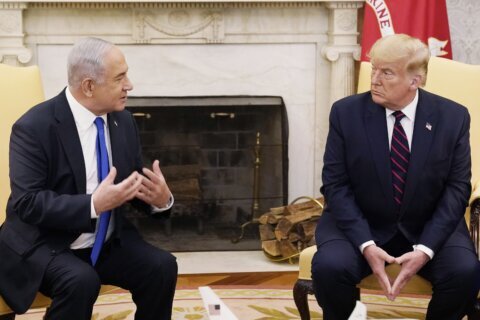WASHINGTON (AP) — The U.S. Interior Department on Monday launched a set of new policies that would require thousands of law enforcement officers to wear body cameras, ensures the release of footage in some critical incidents and restricts the use of so-called no-knock warrants.
The announcement comes after Interior Secretary Deb Haaland launched a task force last year aimed at further building trust between law enforcement and the public. It also follows an executive order from President Joe Biden that focused on federal law enforcement agencies and required them to review and revise policies on use of force.
The policies apply to the thousands of law enforcement officers who work for the Interior Department, in the Bureau of Indian Affairs, Bureau of Land Management, the U.S. Fish and Wildlife Service and the National Park Service. The agency has about 3,100 permanent law enforcement officers.
While some federal agencies have already started launching body camera programs – including some park rangers, park police officers and Fish and Wildlife officers – the federal government has lagged behind many local police departments whose officers have been using body cameras for years.
One of the new policies specifically requires all Interior Department law enforcement officers who are patrolling or engaging with the public to carry body-worn cameras and sets out the department’s intent to expedite the public release of video after an incident that results in serious injury or death.
The Interior Department’s law enforcement arms have faced scrutiny in recent years, particularly the U.S. Park Police who were faulted in an inspector general’s report after officers used smoke grenades and pepper balls to clear racial justice protesters from an area in front of the White House in 2020.
Ghaisar case
The agency also faced scrutiny over its lack of cameras after two U.S. Park Police officers fatally shot unarmed motorist Bijan Ghaisar in Northern Virginia in November 2017.
Virginia Sen. Mark Warner told WTOP that he has been a longtime advocate for body cameras and for changes to policies about use of force. He said he still has lingering questions about Ghaisar’s death almost five years ago along the George Washington Parkway.
And while Warner said the new policies are a “small step forward,” the Ghaisar family is “still owed a better explanation” for what happened.
Warner said the Ghaisar family has asked for policing improvements, and he pointed to the only video evidence from the night of Bijan Ghaisar’s fatal shooting, which was captured by Fairfax County police cameras.
“And having body cameras. I mean, we think about the brutal death of George Floyd … this notion and need to have body cameras. This is not a new. It’s not a new phenomenon … I’m glad that the (Interior) Department is finally moving in this direction, but it does feel like … it’s been a slow, slow process,” Warner said.
U.S. Rep. Don Beyer, who represents parts of Fairfax County, said in a statement that the reforms by the Interior Department will “increase transparency and accountability while improving trust in the communities its officers police.”
“The updated use-of-force guidelines are particularly salient to my district following the killing of Bijan Ghaisar, and the restriction on no-knock entries is an important policy that should be adopted by police everywhere,” Beyer said.
‘No knock’ warrants
Under the policy, officers or agents are required to activate the body-worn cameras “at the earliest possible opportunity of an interaction and should capture as much of the event as possible, starting with the decision to engage an individual or vehicle.” The camera should remain running until the event is over, the policy states.
The policy says the Interior Department “will strive to expedite the public release” of footage after incidents that involve “serious bodily injury or death in order to promote transparency and accountability.”
Another of the policies restricts the use of “no-knock” warrants, which allow law enforcement agents to enter a home without announcing their presence. A no-knock warrant, as its name implies, is an order from a judge that allows police to enter a home without prior notification to the residents, such as ringing a doorbell or banging on the door. In most cases, the law requires that officers must knock and announce themselves before entering a private home to execute a search warrant.
The updated policy – similar to the policy implemented by the Justice Department for its officers last year – follows the March 2020 death of Breonna Taylor, who was shot and killed by police in her home during a no-knock warrant and whose death led to months of mass protests over racial injustice in policing and the treatment of Black people in the United States.
The policy curtails the use of no-knock entries to instances where announcing the presence of federal officers “would create an imminent threat of physical violence to the agent and/or another person,” the Interior Department said. It also requires agents to first obtain approval from supervisors and a federal prosecutor before seeking a no-knock warrant.
The new policies also provide additional guidance on use of force incidents, laying out that its policy would meet or exceed the policies set out by the Justice Department. It also requires the law enforcement agencies to collect and report data about the number of use of force incidents and reiterates a ban on carotid restraints and chokeholds, except when deadly force has been authorized.
“Every single day across the country, the Interior Department’s law enforcement officers risk their lives to safeguard our communities, public lands and waters, and critical resources,” said Deputy Secretary Tommy Beaudreau. “In reforming policing practices, the Department is helping strengthen the unique connection that law enforcement officers have with the communities that they serve and move the nation forward towards community-focused law enforcement.”
WTOP’s Neal Augenstein contributed to this report.
Copyright © 2024 The Associated Press. All rights reserved. This material may not be published, broadcast, written or redistributed.







